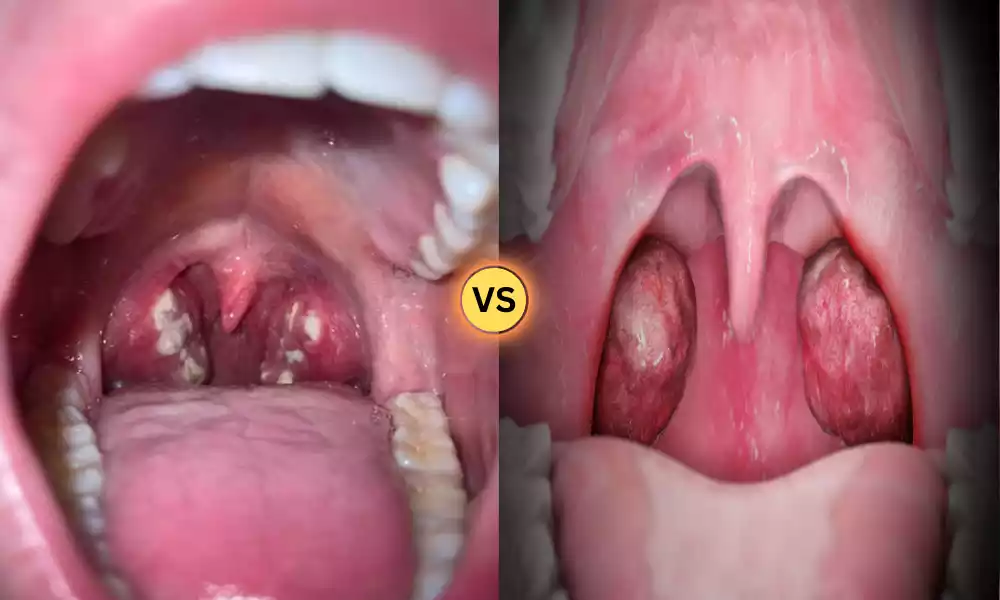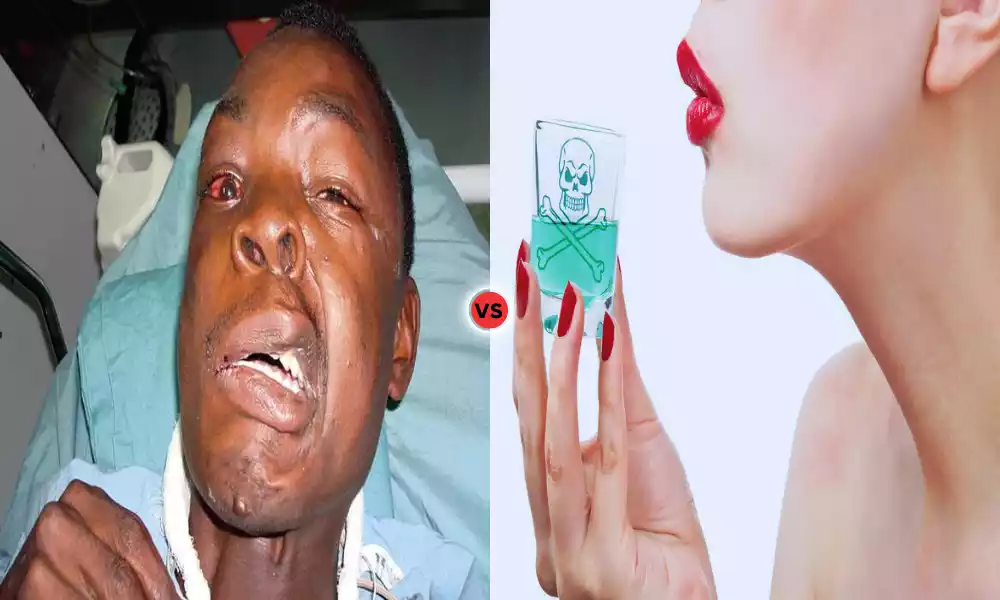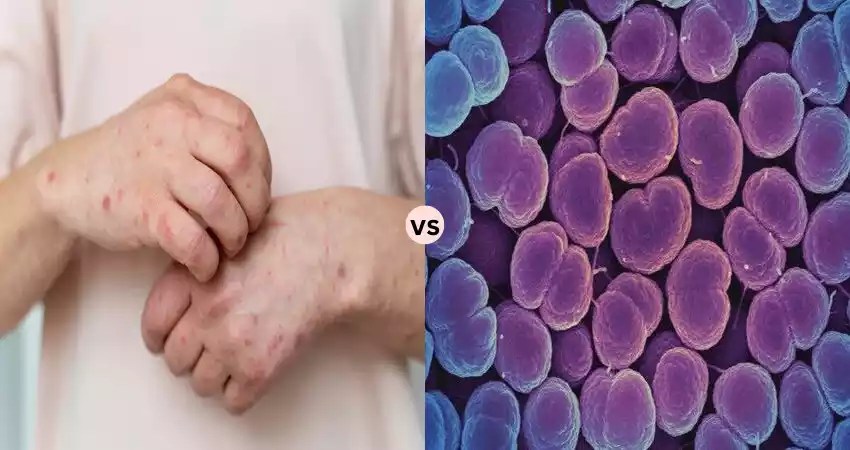Mono and Tonsillitis are both medical conditions related to the throat, but they stem from different causes. Mono, often called the “kissing disease,” is a viral illness predominantly caused by the Epstein-Barr virus and is known for symptoms like fatigue and sore throat. On the other hand, Tonsillitis is the inflammation of the tonsils and can be triggered by both viral and bacterial infections, presenting symptoms such as a sore throat and swollen tonsils. While they share some symptoms, their treatments and prevention measures vary.
What is Mono?
Mono, short for mononucleosis, is often called the “kissing disease.” It’s an infectious illness caused primarily by the Epstein-Barr virus (EBV), though other viruses can also cause similar symptoms. The disease is named the “kissing disease” because one way it’s spread is through saliva. It can also be spread through blood, coughing, sneezing, or by sharing utensils and dishes.
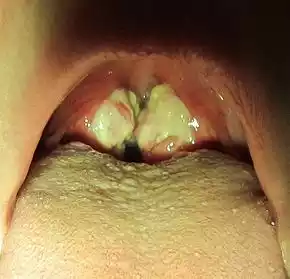
People with mono might experience symptoms like fatigue, sore throat, fever, swollen glands in the neck, enlarged spleen, and a rash. Teenagers and young adults are especially likely to get mononucleosis, though people of any age can become infected.
Most people get infected with EBV at some point in their lives but might not show symptoms. It’s worth noting that once you’ve had mono, you’re typically immune and won’t usually get it again. Treatment mainly involves plenty of rest, adequate hydration, and over-the-counter pain and fever reducers. In most cases, symptoms improve within a few weeks, but fatigue can linger for several months.
Signs and Symptoms of Mono
Mononucleosis, commonly referred to as “mono,” is primarily caused by the Epstein-Barr virus (EBV). The signs and symptoms can vary, but they typically include:
- Fatigue: One of the hallmark symptoms, which can be profound and prolonged.
- Fever: Elevated body temperature is common.
- Sore throat: Often mistaken for strep throat, it can be severe and may persist longer than sore throats from other conditions.
- Swollen lymph nodes: Especially in the neck and armpits. This is a sign that the immune system is fighting the infection.
- Enlarged spleen: The spleen may become enlarged due to the infection, which could potentially make it more susceptible to rupture. In some cases, a physician may advise against contact sports or heavy lifting for a period to prevent splenic rupture.
- Skin rash: Some people with mono might develop a rash, especially if they have been taking antibiotics like amoxicillin or ampicillin.
- Muscle weakness or aches.
- Headache.
- Loss of appetite.
- Jaundice: Yellowing of the skin and eyes can occur, especially if the liver is affected.
- Night sweats.
- Swollen tonsils.
- Soft, swollen spleen or liver (in some cases): This can sometimes be palpated (felt) by a healthcare provider during a physical examination.
The symptoms of mono can last for weeks or even months in some cases. It’s essential to consult with a healthcare professional for diagnosis and advice on managing the condition.
Causes and Transmission of Mono
Mononucleosis, commonly referred to as “mono”, is primarily caused by the Epstein-Barr virus (EBV), a member of the herpesvirus family. Other viruses can also result in a mononucleosis-like syndrome.
Causes:
- Epstein-Barr virus (EBV): The primary cause of mono. Once a person is infected with EBV, the virus remains in their body for life, but it typically becomes dormant after the initial infection.
- Cytomegalovirus (CMV): Another member of the herpesvirus family, CMV can cause a condition that resembles mono.
Transmission: Mono is often termed the “kissing disease” because of its primary mode of transmission, but there are multiple ways the viruses that cause mono can spread:
- Saliva: EBV is most commonly spread through saliva, hence the nickname “kissing disease.” This means it can be contracted through kissing, but also from sharing food, beverages, or personal items like toothbrushes.
- Blood and body fluids: In some cases, EBV can be transmitted through blood transfusions, organ transplants, or contact with infected blood. CMV can also be transmitted through sexual contact, blood transfusions, organ transplants, or contact with infected urine or saliva.
- Coughing or sneezing: As with many viruses, droplets from a cough or sneeze from an infected person can transmit the virus.
- Organ transplants: In some cases, the virus can be transmitted through organ transplantation.
A person who had mono years before can still transmit the virus to others, even if they’re not showing symptoms. This is because the EBV remains dormant in the body and can occasionally reactivate. However, this person might not feel ill during reactivation, yet they can still spread the virus to others.
What is Tonsillitis?
Tonsillitis is an inflammation of the tonsils, which are two oval-shaped pads of tissue located at the back of the throat, one on each side. This condition can be caused by either a viral or bacterial infection. Common symptoms of tonsillitis include a sore throat, swollen tonsils, difficulty swallowing, fever, and swollen lymph nodes in the neck.
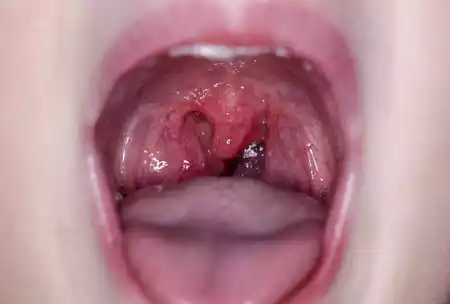
The treatment for tonsillitis varies depending on its cause; bacterial tonsillitis is typically treated with antibiotics, while viral tonsillitis is managed with rest, hydration, and over-the-counter pain relievers. In chronic or recurrent cases, a tonsillectomy, or surgical removal of the tonsils, may be recommended.
Signs and Symptoms of Tonsillitis
Tonsillitis refers to inflammation of the tonsils, which are the two oval-shaped pads of tissue at the back of the throat. Tonsillitis can be caused by both viral and bacterial infections. Here are the common signs and symptoms of tonsillitis:
- Sore throat: Often severe and sudden in onset, it may be painful to swallow.
- Swollen tonsils: The tonsils become enlarged and may have a white or yellowish coating.
- Reddened tonsils: They may appear red and inflamed.
- Swollen lymph nodes: Particularly in the neck, indicating the body’s response to infection.
- Fever: Elevated body temperature is common with tonsillitis.
- Bad breath (halitosis).
- Difficulty swallowing or painful swallowing.
- Voice changes: The voice may become muffled or hoarse.
- Stiff neck.
- Headache.
- Loss of appetite.
- Ear pain: This can occur because the throat and the ears share some nerve pathways.
- Difficulty opening the mouth or trismus.
- Tonsillar exudate: White or yellow patches or pus on the tonsils.
- Young children may also exhibit:
- Drooling due to difficulty swallowing.
- Irritability.
- Refusal to eat.
- Abdominal pain (especially in younger children).
It’s important to differentiate viral from bacterial tonsillitis because the treatment approach can be different. Bacterial tonsillitis (often caused by Streptococcus pyogenes) may require antibiotic treatment, while viral tonsillitis typically does not. If someone suspects they have tonsillitis, they should consult with a healthcare professional for a proper diagnosis and treatment recommendations.
Causes and Transmission of Tonsillitis
Tonsillitis is an inflammation of the tonsils, the two oval-shaped pads of tissue located at the back of the throat. Tonsillitis can be caused by both viral and bacterial agents.
Causes:
- Viral infections: Most cases of tonsillitis are caused by viruses. Common viruses include:
- Rhinovirus (common cold)
- Influenza virus (flu)
- Epstein-Barr virus (EBV) – which also causes mononucleosis
- Adenovirus
- Respiratory syncytial virus (RSV)
- Parainfluenza viruses
- Enteroviruses
- Coronavirus
- Bacterial infections: The most common bacterial cause of tonsillitis is the Streptococcus pyogenes bacterium, also known as group A streptococcus, which is responsible for strep throat.
Transmission:
- Droplets: Both viral and bacterial tonsillitis are mainly spread through droplets when an infected person coughs or sneezes.
- Direct contact: Touching an object or surface with the virus or bacteria on it, then touching your mouth, nose, or eyes before washing your hands can also lead to infection.
- Oral contact: Kissing or sharing food, drinks, utensils, or toothbrushes with an infected person can spread the causative agents of tonsillitis.
- Contaminated surfaces: Viruses and bacteria can survive on surfaces for varying periods, depending on the specific pathogen and environmental conditions. Touching a contaminated surface and then touching the mouth or face can lead to infection.
It’s essential to maintain good hygiene practices, such as washing hands frequently and avoiding close contact with infected individuals, to prevent the spread of tonsillitis. If someone is suspected of having bacterial tonsillitis (strep throat), it’s crucial to get diagnosed and treated promptly as untreated strep infections can lead to more serious complications.
Comparison table of Mono and Tonsillitis
Here’s a basic comparison table of Mono (Mononucleosis) and Tonsillitis:
| Feature | Mono (Mononucleosis) | Tonsillitis |
|---|---|---|
| Causing Agent | Mainly Epstein-Barr virus (EBV) | Viral or bacterial (e.g., Streptococcus) |
| Transmission | Primarily through saliva, also blood and other body fluids | Usually through droplets (coughing, sneezing) or direct contact |
| Primary Affected Area | Lymph nodes, spleen, throat | Tonsils |
| Main Symptoms | Fatigue, sore throat, fever, swollen lymph nodes, enlarged spleen | Sore throat, swollen tonsils, difficulty swallowing, fever |
| Diagnosis | Blood test (Monospot), antibody tests | Throat swab (to identify bacterial cause) |
| Treatment | Rest, hydration, over-the-counter pain relievers | Depends on cause: antibiotics for bacterial; rest, hydration, pain relievers for viral |
| Age Group Most Affected | Teenagers and young adults | All age groups, especially children |
| Complications | Enlarged spleen, hepatitis, jaundice | Abscess formation, spread of infection |
| Chronic/Recurrent Cases | Rare (once infected, usually immune) | Possible, may lead to recommendation for tonsillectomy |
While this table provides a general comparison, individual cases may vary, and a healthcare professional should always be consulted for proper diagnosis and treatment.
Similarities between Mono and Tonsillitis
Mononucleosis (often called “mono”) and tonsillitis are both conditions that affect the throat and can exhibit overlapping symptoms. Here are the similarities between the two:
- Symptoms Overlap:
- Sore throat: Both conditions can result in a sore throat, which can be severe.
- Fever: Elevated body temperature is common in both conditions.
- Swollen lymph nodes: Particularly in the neck, indicating the body’s response to infection.
- Fatigue: Individuals with either condition may experience tiredness.
- Causative Agents: Both conditions can be caused by viruses. While mono is primarily caused by the Epstein-Barr virus (EBV), tonsillitis can be caused by a variety of viruses, including EBV.
- Mode of Transmission: Both conditions can be spread through saliva and respiratory droplets. They can both be contracted from close personal contact, such as kissing, or from sharing items like utensils or drinks.
- Treatment Approach for Viral Causes: When tonsillitis is viral, and in cases of mono, treatment primarily focuses on symptom relief, as antibiotics aren’t effective against viruses. Over-the-counter pain relievers, rest, and hydration are common recommendations.
- Potential Complication: Both conditions can result in an enlarged spleen, although it’s more commonly associated with mono.
- Throat Appearance: Both can result in a visibly inflamed throat. With mono, the tonsils might become coated or streaked with white, while with tonsillitis, the tonsils can be swollen and reddened, sometimes with white or yellow spots of pus.
- Recovery Time: Both conditions can sometimes lead to prolonged symptoms, especially fatigue, which might last for several weeks.
- Prevention: The primary prevention measures, such as avoiding close contact with infected individuals, practicing good hygiene, and not sharing personal items, apply to both conditions.
While mono and tonsillitis share these similarities, they are distinct conditions with differences in etiology, presentation, and potential complications. If someone experiences symptoms of either condition, they should seek medical advice for an accurate diagnosis and appropriate treatment.
Diagnosis of Mono and Tonsillitis
Diagnosing mononucleosis (mono) and tonsillitis involves a combination of clinical examination, patient history, and specific tests.

Here’s how each condition is typically diagnosed:
Mononucleosis (Mono):
- Clinical Examination: A healthcare professional may check for signs like swollen lymph nodes, tonsils, liver, or spleen.
- Patient History: Information about recent symptoms, their duration, and potential exposure to someone with mono can provide important clues.
- Monospot Test: This is a rapid test that can detect mononucleosis antibodies. It is quick and can be done in the doctor’s office, but it might not detect the disease in the first week of its symptoms.
- EBV Antibody Test: This is a more definitive test that measures specific antibodies related to the Epstein-Barr virus (EBV) in the blood.
Tonsillitis:
- Clinical Examination: A healthcare provider will examine the throat for swollen, red tonsils, and potentially white or yellow patches or streaks of pus. They may also check for swollen lymph nodes in the neck.
- Patient History: Asking about the severity and duration of symptoms and any potential exposure to strep throat or other infections can be indicative.
- Throat Swab: To determine whether the cause is bacterial, a swab of the throat or tonsils can be taken and tested for the presence of streptococcal bacteria. This is crucial since bacterial tonsillitis (like strep throat) requires antibiotic treatment.
- Complete Blood Count (CBC): A blood test might be done in some cases to distinguish between viral and bacterial causes, as certain markers in the blood can provide clues about the type of infection.
For both conditions, a thorough medical examination and history play a crucial role in determining the most appropriate diagnostic tests. It’s essential to consult with a healthcare professional for an accurate diagnosis and appropriate treatment.
Treatment Options for Mono and Tonsillitis
Both mononucleosis (mono) and tonsillitis can cause discomfort and similar symptoms like sore throat and fever, but their treatment approaches differ based on their causes and specific symptoms. Here’s a breakdown of treatment options for both conditions:
Mononucleosis (Mono):
Mono is caused by the Epstein-Barr virus (EBV), and since it’s viral, antibiotics aren’t effective against it. Treatment is primarily aimed at relieving symptoms:
- Rest: It’s crucial, especially during the acute phase, to help the body recover. Some people may need several weeks of rest.
- Hydration: Drinking fluids prevents dehydration and soothes a sore throat.
- Over-the-counter pain relievers: Medications like acetaminophen (Tylenol) or ibuprofen (Advil) can help reduce fever and relieve pain. However, it’s important to avoid aspirin in children and teenagers as it can lead to a rare but severe condition called Reye’s syndrome.
- Avoiding strenuous activities: Particularly anything that might lead to abdominal injury, as mono can cause an enlarged spleen that’s more susceptible to rupture.
Tonsillitis:
The treatment of tonsillitis depends on whether it’s viral or bacterial:
- Viral tonsillitis:
- Rest and hydration are essential.
- Over-the-counter pain relievers like acetaminophen or ibuprofen can help manage pain and reduce fever.
- Throat lozenges or saline gargles can help soothe a sore throat.
- Bacterial tonsillitis (commonly caused by Streptococcus pyogenes):
- Antibiotics: Essential for treating bacterial tonsillitis. Penicillin or amoxicillin are commonly prescribed. It’s crucial to complete the entire course, even if symptoms improve before the medication is finished.
- As with viral tonsillitis, rest, hydration, pain relievers, and throat lozenges can also be beneficial.
- Recurrent or chronic tonsillitis:
- Tonsillectomy: If someone has multiple episodes of severe tonsillitis in a year, a doctor might recommend a tonsillectomy, which is the surgical removal of the tonsils.
In both conditions, it’s essential to consult with a healthcare professional for an accurate diagnosis and appropriate treatment.
Prevention Measures of Mono and Tonsillitis
Preventing mononucleosis (mono) and tonsillitis involves adopting measures to reduce the risk of viral and bacterial infections. Here’s how you can prevent both:
Mononucleosis (Mono):
- Avoid sharing personal items: As mono can be spread through saliva, avoid sharing drinks, food, utensils, or personal items such as toothbrushes with others.
- Avoid close contact: Try to avoid close contact, such as kissing, with someone who has mono until they’re symptom-free.
- Practice good hygiene: Wash your hands frequently and thoroughly with soap and water. Use hand sanitizer if soap and water aren’t available.
- Avoid touching your face: Refrain from touching your eyes, nose, or mouth, as this can introduce viruses into your body.
Tonsillitis:
- Avoid contact with infected individuals: If someone is known to have tonsillitis, especially if it’s caused by the Streptococcus bacteria (strep throat), avoid close contact with them until they’ve been on antibiotics for at least 24 hours or they’re no longer contagious.
- Practice good hygiene:
- Wash hands frequently: This is one of the most effective ways to prevent many infections. Ensure thorough washing for at least 20 seconds, especially after coughing or sneezing and before eating.
- Use hand sanitizer: If soap and water aren’t available, hand sanitizers with at least 60% alcohol can be an alternative.
- Cover your mouth and nose: If you cough or sneeze, do so into a tissue or the crook of your elbow to prevent spreading droplets.
- Don’t share personal items: Like with mono, avoid sharing utensils, drinks, or personal items with others, especially with someone showing symptoms of an illness.
- Disinfect surfaces: Regularly clean and disinfect commonly touched surfaces like doorknobs, remote controls, and light switches.
- Maintain a healthy lifestyle: A robust immune system can ward off infections better. Ensure you have a balanced diet, get regular exercise, have enough sleep, and manage stress.
While these preventive measures can significantly reduce the risk of getting infected, they cannot guarantee complete protection. It’s always essential to be vigilant and seek medical advice if symptoms of either mono or tonsillitis appear.
Conclusion
Mononucleosis (mono) and tonsillitis are both medical conditions that primarily affect the throat and can display overlapping symptoms such as sore throat, fever, and swollen lymph nodes. Mono, often referred to as the “kissing disease,” is primarily caused by the Epstein-Barr virus and is characterized by prolonged fatigue and potential spleen enlargement.
Tonsillitis, on the other hand, refers to the inflammation of the tonsils and can be triggered by both bacterial and viral agents. While both conditions can be transmitted through saliva and respiratory droplets, their treatments differ based on their causes. Antibiotics are effective against bacterial tonsillitis but not for viral infections, including mono. Prompt medical diagnosis and treatment are essential for both conditions to manage symptoms and prevent complications.

